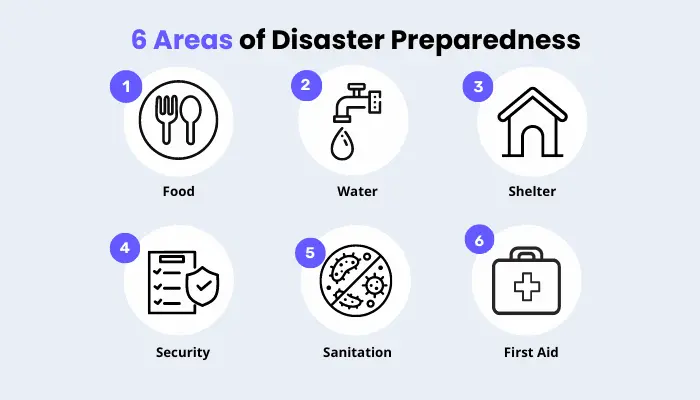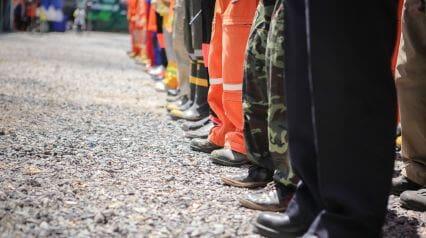What is Disaster Preparedness?
Disaster preparedness refers to the set of measures and practices done to mitigate the effects of disasters such as storms, hurricanes, floods, earthquakes, and the like on businesses, communities, and individuals. It involves creating emergency plans, preparing specific kits for different disasters and incidents, managing supplies, and conducting regular trainings.
Importance
Each member of society, from the government to businesses, to communities, to individuals, are all responsible for preparing for disasters, not only for the organization that they belong to or their own sake, but for those around them. Disaster preparedness serves as a proactive strategy to minimize loss of life, property damage, and social disruption. By having comprehensive plans in place, organizations, communities, and individuals can respond swiftly and effectively, reducing the damage and chaos that often accompanies emergencies.
Disaster preparedness is also not just limited to immediate response following a harrowing event, as it also covers the recovery phase that follows it. Proper planning and preparedness ensure that the recovery process is smoother and faster, minimizing the long-term impacts of disasters. Furthermore, preparedness efforts foster a sense of unity and collaboration within communities, as individuals come together to support one another during challenging times.
Other benefits disaster preparedness offers include:
- Reduced loss of life and property
- Faster recovery and restoration
- Enhanced collaboration
Improve your EHS Management
Cultivate a safe working environment and streamline compliance with our EHS solutions.
Explore nowElements of Disaster Preparedness
Disaster preparedness can be a long process as disasters themselves can be unpredictable. It has now become the norm to have disaster plans in case of emergencies, as well as disaster kits, and regular discussions on the possible disasters we may face in our daily lives. A good way to ensure you and your community are prepared for one includes the following:
- Maintaining equipment to be used for disasters regularly
- Establishing a clear chain of command and order of operations to be followed in times of disaster
- Having disaster preparedness kits easily accessible to you at all times with the following items:
- Non-perishable food
- Water
- Medications
- Clothes
- Important documents
- First aid supplies
- Whistles and flash lights
- Maps
- Radio with batteries
- Conducting or attending regular training sessions related to disaster preparedness
- Ensuring the necessary safety tools are always readily available and are easy to use in times of disaster and emergency
Digitize the way you Work
Empower your team with SafetyCulture to perform checks, train staff, report issues, and automate tasks with our digital platform.
Get Started for FreeWhat are the 6 Areas of Disaster Preparedness?

Disaster preparedness is focused on 6 key areas and ensuring they are available to us even in times of emergency. These are:
- Food: Is there enough nutritional food to go around, and is it stored properly?
- Water: Is there access to clean drinking water?
- Shelter: Where is the nearest and safest shelter available?
- Security: How can you keep yourself safe in times of disaster and its aftermath?
- Sanitation: Can you keep yourself sanitized, disinfected, and free from injury regularly?
- First aid: Do you have the resources to treat any possible injuries?
These areas are the main things to consider when preparing for disasters. Having easy access to these consistently is essential to human survival, thus making them the focus of all disaster preparedness plans and kits.
Training to Prepare for Disasters
There are many ways to prepare for disasters and mitigate their effects, especially since they tend to suddenly happen with varying levels of intensity that nobody can predict. This includes having the necessary kits, communication channels ready, and more.
However, another way to ensure disaster preparedness is by having regular training sessions for them. Training programs and workshops serve as opportunities for sharing vital information and disseminating them, as here, participants learn about various types of disasters, potential risks, and the best practices for responding to each situation.
Through regular training sessions, people learn more about first aid, CPR, fire extinguisher use, and search and rescue techniques, among others. These help participants understand the dynamics of emergencies and practice their response in a controlled environment. They also help individuals think critically and make informed decisions during high-pressure situations. Utilizing digital tools for your training sessions is a great way to ensure all the necessary information and latest knowledge about disaster preparedness is shared easily.
FAQs about Disaster Preparedness
Some of the most common misconceptions about disasters and preparing for them include the following:
- Thinking your chances of experiencing a disaster are low, hence not wanting to prepare for them
- Assuming things will return to normal immediately following a disaster and not preparing enough for its aftermath
- Avoiding planning for disasters in general as you believe things will work out on their own
The most common types of natural disasters are:
- Extreme temperature changes
- Hurricanes, tornadoes, and storms
- Floods
- Tsunamis
- Earthquakes
- Landslides
- Volcanic eruptions
As part of disaster preparedness, Red Cross encourages local news sources and government offices to devise plans that will allow them to share information about disasters, effects, and weather changes in any disaster. It is each person’s responsibility to then stay updated on weather updates, warnings, watches, and what actions to take following these.
Ideally, you and your company, community, and family should revisit your disaster preparedness plans every six months. This ensures that all plans are still applicable for use, and that your disaster kits are still usable.
Disasters are different events that can cause serious disruptions to a community, family, business, or individual. Many natural disasters cannot be prevented as they occur naturally and out of human control. However, some man-made disasters, as the name suggests, are the result of human decisions and impact, thus making prevention possible. Examples of these include fires, building breakages, and the like.
Some ways to prevent disasters in these situations include:
- Following building codes
- Orienting and training people on proper safety procedures to follow in different situations
- Installing and using warning systems
- Mainting electrical equipment regularly to avoid any untoward incident with them
- Promoting the use of safe working equipment at all times




